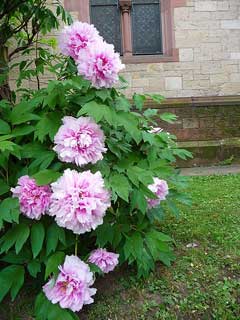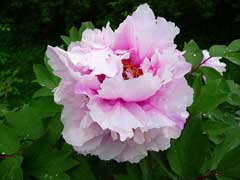 |
|
http://commons.wikimedia.org/wiki/User:4028mdk09 |
 |
| http://commons.wikimedia.org/wiki/User:3268zauber |
Translate this page:
Summary
Bloom Color: Yellow. Main Bloom Time: Early summer, Late spring. Form: Upright or erect.
Physical Characteristics

 Paeonia suffruticosa is a deciduous Shrub growing to 2 m (6ft) by 3 m (9ft) at a slow rate.
Paeonia suffruticosa is a deciduous Shrub growing to 2 m (6ft) by 3 m (9ft) at a slow rate.
See above for USDA hardiness. It is hardy to UK zone 7 and is not frost tender. It is in flower in May. The species is hermaphrodite (has both male and female organs) and is pollinated by Insects. The plant is self-fertile.
Suitable for: light (sandy), medium (loamy) and heavy (clay) soils and can grow in heavy clay soil. Suitable pH: mildly acid, neutral and basic (mildly alkaline) soils and can grow in very alkaline soils.
It can grow in semi-shade (light woodland) or no shade. It prefers moist soil.
UK Hardiness Map
US Hardiness Map
Synonyms
P. moutan. Sims.
Plant Habitats
Woodland Garden Sunny Edge; Dappled Shade; Shady Edge;
Edible Uses
Edible Parts: Flowers
Edible Uses:
Flowers - cooked[46, 61, 177]. The fallen flower petals are parboiled and sweetened for a teatime delicacy, or cooked in various dishes[183].
References More on Edible Uses
Medicinal Uses
Plants For A Future can not take any responsibility for any adverse effects from the use of plants. Always seek advice from a professional before using a plant medicinally.
Analgesic Antibacterial Antiinflammatory Antipyretic Antispasmodic Emmenagogue Sedative Styptic
Tonic
The root and root bark is analgesic, antibacterial, anti-inflammatory, antipyretic, antispasmodic, emmenagogue, sedative, styptic and tonic[46, 61, 174, 176, 178, 218, 279]. An extract of the plant has antibacterial activity, inhibiting the growth of Staphylococcus, Bacillus dysenteriae, Typhoid bacillus, Paratyphoid bacillus, Proteus, Pseudomonas, E. coli, Haemophilus pertussis and Streptococcus[176, 218]. The plant is used internally in the treatment of fevers, boils, menstrual disorders, nosebleeds, ulcers, irritability and gastro-intestinal infections[238]. This remedy should only be used under the supervision of a qualified practitioner[238]. The herb acts as a synergist when used with liquorice (Glycyrrhiza spp)[218]. A tea made from the dried crushed petals of various peony species has been used as a cough remedy, and as a treatment for haemorrhoids and varicose veins[250].
References More on Medicinal Uses
The Bookshop: Edible Plant Books
Our Latest books on Perennial Plants For Food Forests and Permaculture Gardens in paperback or digital formats.

Edible Tropical Plants
Food Forest Plants for Hotter Conditions: 250+ Plants For Tropical Food Forests & Permaculture Gardens.
More

Edible Temperate Plants
Plants for Your Food Forest: 500 Plants for Temperate Food Forests & Permaculture Gardens.
More

More Books
PFAF have eight books available in paperback and digital formats. Browse the shop for more information.
Shop Now
Other Uses
Fuel
The stems are used as firewood[11]. The plant is quite slow growing so could not really be seen as a source of fuel[K].
Special Uses
Scented Plants
References More on Other Uses
Cultivation details
Landscape Uses:Border, Foundation, Seashore, Specimen. Requires a deep rich soil, preferably neutral or slightly alkaline[1], doing quite well in sun or light shade[1]. Prefers a limy soil and a sheltered position[200]. Plants are tolerant of a wide range of soil conditions, but will not survive if the soil becomes waterlogged or is too dry[250]. This species is lime tolerant[200]. Plants grown on sandy soils tend to produce more leaves and less flowers, whilst those growing on clay take longer to become established but produce better blooms[250]. Hardy to about -20°c[184], plants do better in the north of Britain than they do in the south and are generally best if given an open northerly aspect[11]. Plants come into growth early in the year and are then subject to damage by late frosts, they are therefore best sited in a position that is shaded from the early morning sun[11]. The branches are brittle and very subject to wind damage, especially when young[200]. There is some confusion over the name of this species, Chinese botanists believing that it was based on a cultivar. They do not recognise this name, instead raising to specific status two of its sub-species as P. rockii (Haw.&Lauener.) Hong.&Li. and P. jishanensis Hong.&W.Z.Zhao (syn P. spontanea (Rehder.) Hong.&W.Z.Zhao.)[214]. Most modern treatments no longer recognise this as a separate species, though some people use the name to house the large number of garden forms of tree peonies that have been developed over the centuries[250]. A very ornamental plant[1], there are many named varieties[182]. It grows best in areas with long hot summers[1] and requires an airy position because it is very subject to fungal attack[11]. Plants in this genus are notably susceptible to honey fungus[200]. The flowers of some forms of this species are pleasantly scented[245]. Scented forms include 'Flora', 'Fragrans Maxima', 'Kimpai' and 'Kokuho'[245]. Members of this genus are rarely if ever troubled by browsing deer or rabbits[233]. A very greedy plant inhibiting the growth of nearby plants, especially legumes[54]. The plant does not really need much pruning apart from removing dead or diseased stems. It is, however, very tolerant of pruning and can be cut right back to ground level if it requires rejuvenation[200]. Strongly resents root disturbance, taking some time to recover after being divided[1]. Peony species are usually self-fertile, though they will also hybridise with other species if these flower nearby at the same time[250]. Plants take 4 - 5 years to flower from seed[200]. They generally breed true from seed[1]. Cultivated in China as a medicinal plant[214]. Special Features:Attractive foliage, Naturalizing, Suitable for cut flowers, Suitable for dried flowers, Fragrant flowers.
References Carbon Farming Information and Carbon Sequestration Information
Temperature Converter
Type a value in the Celsius field to convert the value to Fahrenheit:
Fahrenheit:
The PFAF Bookshop
Plants For A Future have a number of books available in paperback and digital form. Book titles include Edible Plants, Edible Perennials, Edible Trees,Edible Shrubs, Woodland Gardening, and Temperate Food Forest Plants. Our new book is Food Forest Plants For Hotter Conditions (Tropical and Sub-Tropical).
Shop Now
Plant Propagation
Seed - best sown as soon as it is ripe in a cold frame[250]. When sown fresh, the seed produces a root about 6 weeks after sowing with shoots formed in the spring[200]. Stored seed is much slower, it should be sown as soon as possible in a cold frame but may take 18 months or more to germinate[200]. The roots are very sensitive to disturbance, so many growers allow the seedlings to remain in their pots for 2 growing seasons before potting them up. This allows a better root system to develop that is more resilient to disturbance[250]. If following this practice, make sure you sow the seed thinly, and give regular liquid feeds in the growing season to ensure the plants are well fed. We usually prick out the seedlings into individual pots as soon as they are large enough to handle, and then grow them on in a cold frame for at least two growing seasons before planting them out when they are in growth in the spring[K].
Other Names
If available other names are mentioned here
Native Range
Coming Soon
Weed Potential
Right plant wrong place. We are currently updating this section.
Please note that a plant may be invasive in one area but may not in your area so it's worth checking.
Conservation Status
IUCN Red List of Threatened Plants Status :

Growth: S = slow M = medium F = fast. Soil: L = light (sandy) M = medium H = heavy (clay). pH: A = acid N = neutral B = basic (alkaline). Shade: F = full shade S = semi-shade N = no shade. Moisture: D = dry M = Moist We = wet Wa = water.
Now available:
Food Forest Plants for Mediterranean Conditions
350+ Perennial Plants For Mediterranean and Drier Food Forests and Permaculture Gardens.
[Paperback and eBook]
This is the third in Plants For A Future's series of plant guides for food forests tailored to
specific climate zones. Following volumes on temperate and tropical ecosystems, this book focuses
on species suited to Mediterranean conditions—regions with hot, dry summers and cool, wet winters,
often facing the added challenge of climate change.
Read More
Expert comment
Author
Andrews.
Botanical References
11200266
Links / References
For a list of references used on this page please go here
Readers comment
© 2010, Plants For A Future. Plants For A Future is a charitable company limited by guarantee, registered in England and Wales. Charity No. 1057719, Company No. 3204567.